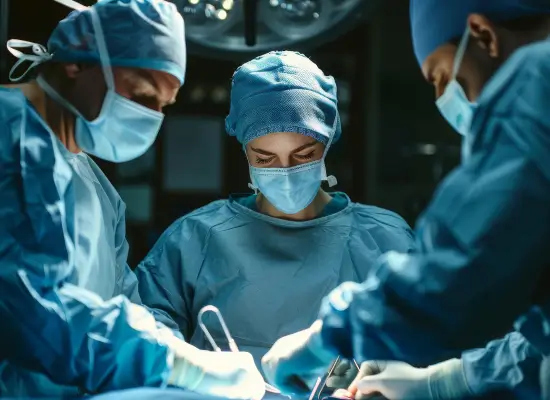VATS surgery is very effective for conditions, such as lung cancer, pleural effusion, and other chest diseases, but your physician will decide whether it is appropriate for you.

Synopsis
Are you one of those who still believe thoracic surgeries are meant to be extensive and complex? If so, it is time to rethink that notion. VATS, or Video-assisted thoracoscopic surgery, is a new game-changer in complex thoracic diseases and their treatments. This article will guide you through this revolutionary procedure in modern medicine, covering what to expect during and after the surgery.
Introduction
Thoracic disease patients have historically faced the challenge of large incisions, long recovery times, and post-operative pain for their treatment. VATS, or Video-assisted thoracoscopic surgery, is a remarkable alternative to traditional open-chest surgery. VATS is a perfect combination of precision and minimalism, which have drastically changed the landscape of chest and lung surgery. It offers a precise solution for a wide range of diseases, which include:
- Lung Cancer
- Esophageal Disorders
- Pleural Mesothelioma
- Chest Cancer
- Hyperhidrosis
Like any other major surgery, VATS is a complex procedure that requires the finest care and precision from an expert faculty. These are precisely what you can expect at Gleneagles Hospital, equipped with the latest technology and the highest standards of safety and care.
What is VATS Surgery?
Video-assisted thoracoscopic Surgery, or VATS, is a minimally invasive surgical method in which small cuts are made in the chest to insert a thoracoscope. A thoracoscope is a very thin tube with a very small video camera, which is used by surgeons to see what is inside the chest cavity on a monitor in real time. VATS surgery in Hyderabad utilises real-time guidance to carry out a range of diagnostic and therapeutic interventions with the assistance of dedicated surgical instruments. The thoracoscope is passed through independent small incisions. Thoracoscopic refers to the technique of examining the thoracic region using a scope, enabling surgeons to execute delicate interventions more precisely and with less interference with adjacent tissue.

Types of VATS Procedures
VATS surgery in Hyderabad or anywhere in the world can be divided into various types, each used for treating different lung and chest issues. Here is a list of some of the most common types of VATS procedures:
- VATS Lobectomy: This procedure involves removing a lobe of the lung, typically the one containing cancerous cells. This type of VATS is one of the most common applications of VATS.
- Esophagectomy: Esophagectomy is used in the treatment of the oesophagus by removing a part or whole of the oesophagus. This type is generally used in treating oesophageal cancer by eliminating the need for large incisions.
- Lung Volume Reduction Surgery (LVRS): LVRS is generally used to treat individuals suffering from severe emphysema or COPD. The parts of the damaged lung tissue are removed using VATS to enhance the efficiency of breathing.
- Pericardiectomy: This type is used for patients suffering from pericardial diseases (diseases of the heart membrane). Pericardiectomy includes the removal of a part or complete pericardium.
- Thymectomy: VATS is employed to remove a diseased thymus gland, usually affected by the condition of myasthenia gravis or thymoma.
Your health matters – get expert advice today.
Preparation for VATS Surgery in Hyderabad
VATS surgery in Hyderabad or anywhere in the world requires patients to thoroughly prepare for the surgery with the help of a surgeon. Pre-surgical preparation is done to ensure the optimal conditions for the surgery. These are some of the preparatory steps you may expect before the actual surgery:
- Evaluation of Medical History: This is the first and foremost important step for ensuring a smooth surgery. During this, your surgeons will evaluate the patient’s medical history, such as health conditions, allergies, previous surgeries, or any genetic disease.
- Imaging and Diagnostic Tests: Imaging tests like CT scans, X-rays, or PET scans are conducted to visualise the cause of lung or chest diseases. The visualisation helps locate the exact affected point or determine the size of any tumours within the chest.
- Blood Tests: Blood tests are a powerful indicator of any blood-related issues, which can be a contributing factor in thoracic disease. These are also done to evaluate the overall health of a patient. This may include evaluation of kidney function, blood clotting ability, and the presence of any infection.
- Medications and Lifestyle Changes: Before the surgery, patients are also instructed to stop certain medications. However, no need to stop these medications if not suggested by your surgeon. Hence, it is important to share any information regarding these medicines with your surgeon.
Procedure of VATS Surgery in Hyderabad
The procedure of VATS Surgery in Hyderabad follows a similar protocol for the surgery, which is done under general anaesthesia. The protocol generally includes the following steps:
- Incisions and Insertion of Thoracoscope: The surgery starts with small cuts and incisions on the chest. The doctor creates small cuts (typically 1 to 2 centimetres) and passes the thoracoscope through one of the incisions. The thoracoscope has a small camera that sends live images of the chest cavity to a monitor.
- Inserting Surgical Tools: With other minor incisions, the surgeon introduces specialised tools to cut out or address the unhealthy tissue. Whether it is a tumour, fluid, or destroyed lung tissue, these surgical tools are used.
- Directed Surgery: The surgeon navigates the operation using the pictures from the thoracoscope to ensure accuracy. Real-time imaging also helps avoid harming the surrounding organs and tissues.
- Closing the Incisions: After the required procedure has been done, the incisions are closed using sutures or staples. A chest tube might also be inserted temporarily to drain air or fluid from the chest cavity.
Robotic-Assisted VATS
Robotic-Assisted VATS is another form of this surgery, which is used to enhance precision and accuracy of the procedure. The robotic instruments are controlled by the surgeons, which allows the them to easily go through smaller incisions. Robotic-Assisted VATS has recently gained popularity for its enhanced precision and even less invasive approach.
Recovery and Aftercare
The recovery process for VATS is much faster than the traditional open-chest surgeries. It generally takes 2 to 3 hours for the complete surgery and a few days in a hospital for full recovery. However, recovery time can vary based on the condition of a patient after the surgery and the condition being treated. During your stay in a hospital, pain management medications are prescribed to reduce mild discomfort and soreness in the area of incisions.
You may also opt for physiotherapy for better and faster recovery after your discharge. Patients are also suggested not to lift heavy weights or indulge in strenuous activities for a few weeks after the surgery as a precautionary measure. Regular checkups and counselling sessions with your doctor are a crucial part of your aftercare regime. During these follow-ups, doctors may look for any complications or potential risks.
Risks and Complications
VATS surgery in Hyderabad or anywhere offers a large number of benefits. However, like any other major surgical procedure, this procedure also poses some potential threats to the health of a patient. These may include:
- Infection: While the chances of this are less than the standard operation, infection can occur at the point of incision.
- Bleeding: Bleeding is common during or after the operation. However, too much bleeding can result in serious complications.
- Pneumothorax: It is the partial collapse of the lung for a short period, which requires extra and proper care.
- Organ Damage: Although a rare condition, possible injury to structures near the incision can occur, such as the blood vessels or the heart.
Why Choose Gleneagles Hospital for VATS surgery in Hyderabad?
Gleneagles Hospitals is a leading provider of solutions for thoracic procedures like VATS surgery in Hyderabad. With health complications like lung or chest cancer, you can not take risks, which is why choosing a premier healthcare centre becomes crucial. Here are some reasons why Gleneagles Hospitals can be the perfect choice for you or your loved one suffering from complex lung or chest issues:
- The expert team of Cardiothoracic surgeons who are passionate about treating patients with precision.
- A multidisciplinary approach towards the procedure so that the surgeons and doctors work together for a positive outcome.
- The hospital is equipped with the latest technology and modern infrastructure to provide patients with the best possible care during their stay.
- Personalised care to fit the particular needs of a specific patient.
Our Doctors
View allFrequently Asked Questions
The majority of patients might be required to stay for a few days after VATS surgery, depending on their recovery.
VATS employs tiny cuts and a thoracoscope to conduct surgery, while open thoracic surgery employs larger incisions and more invasive methods.
VATS surgery is typically less painful and uncomfortable than open thoracic surgery because of its minimal invasiveness.













